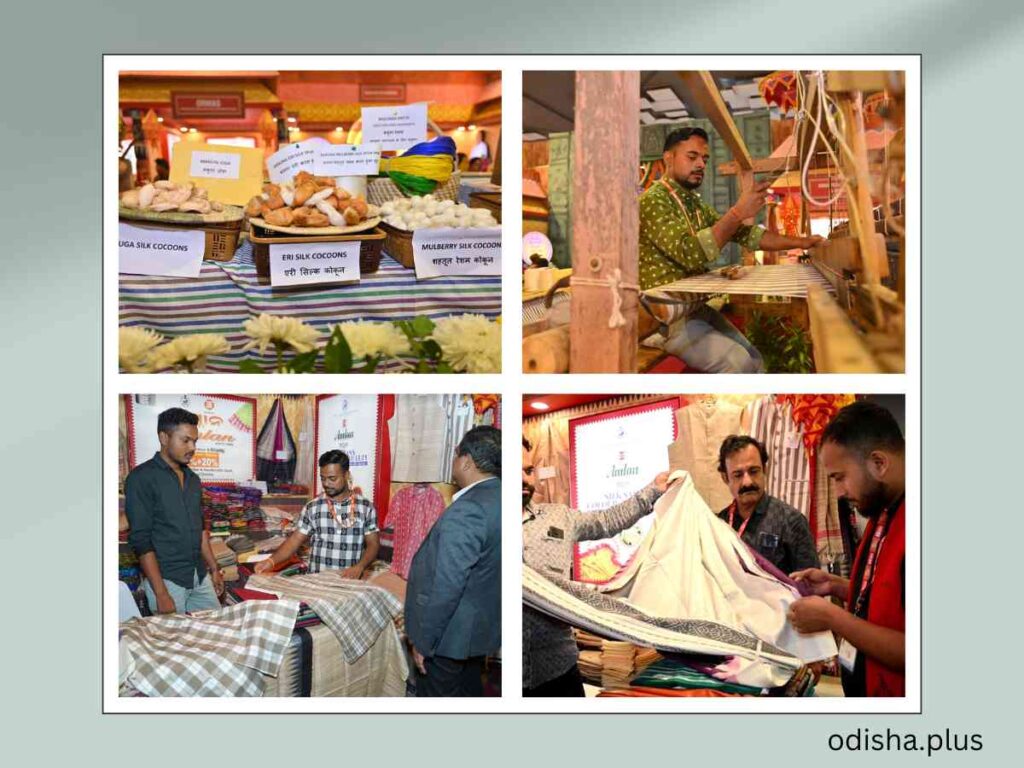‘Karuna Silk’ a new variation in Indian Textile industry encouraging cruelty-free practices & zero artificial dye
OdishaPlus Bureau

The cruelty-free & artificial-dye-free ‘Karuna Silk’ from Odisha catches attention of the visitors & fashion lovers at India International Trade Fair, New Delhi.
Promoted by Handlooms, Textiles & Handicrafts Department, Government of Odisha, the live demonstration of this new variant of silk at ‘Odisha Mandap’ showcases the ethical & sustainable silk production redefining traditional methods.
Odisha exhibits unique handlooms, handicrafts, tribal artworks and rural produce at the trade fair ongoing at Bharat Mandapam. As a part of the bouquet, the state highlights the process of ‘Karuna Silk’ production from growing of silkworms to weaving. The final products like sarees, cloth materials & modern jackets of the silk are showcased & sold at the state run ‘Amlan’ outlet under Directorate of Textiles.
Weavers from Gopalpur region of Jajpur, Odisha, are demonstrating the traditional weaving techniques live of ‘Karuna Silk’ drawing attention of the visitors to the pavilion.
“I learned about Odisha’s ‘Karuna Silk’ for the first time at the trade fair. The method of producing silk without harming the silkworms and not using any chemical dyes is new & innovative,” says Udit Jain a visitor from Delhi.
“The visitors to Odisha pavilion are showing keen interest in Karuna Silk garments. While witnessing the process of ‘Karuna Silk’ production they visit our stall to experience the finish products,” says Babuli Das from Amlan outlet at IITF.
‘Karuna’, which means compassion in Odia, makes ‘Karuna Silk’ unique in its process. This method allows extraction of silk without killing the silkworms. Usually, the cocoon carrying the live worm inside it, is boiled in water before extracting the fibres. But in ‘Karuna Silk’ production the silk worm is allowed to grow & fly away as a butterfly by rupturing the cocoon. Then, the hatched cocoons are collected & the silk threads are extracted from them.
As per experts, the production of a single mulberry silk saree requires between 10,000 to 20,000 cocoons. Similarly, creating a tassar silk saree requires around 5,000 to 7,000 cocoons. Hence, the same number of silkworms lose their lives in the process. However, ‘Karuna Silk’ has become an exception.
“The ‘Karuna Silk’ at Odisha pavilion captivates the attention of people. This cruelty-free approach in the silk production is remarkable,” explains Anant Ojha, a native from Odisha currently residing in Delhi.
Since a couple of years, the state government has introduced the sans cruelty ‘Karuna Silk’ as the traditional ‘Khandua Patta’ for Shree Jagannath Temple, Puri. Weavers from the Rautapada region near Khorda are producing this typical silk by inscribing the verses of ‘Geeta Govinda’ by Poet Jaydev on it.
Odisha grows 4 types of Silk namely Eri, Mulberry, Tassar & Muga. Earlier Eri Silkworms were reared for producing ‘Karuna Silk’. But recently the silk is being extracted from all 4 variants. Odisha government encourages cultivation of various types of silk across 22 districts of the state.
Earlier, artificial dye was used to colour ‘Karuna Silk’ while producing various fabrics. However, in the current variant the natural colour of the silk fibre is kept as it is, promoting a new practise in Indian textile production.
The directorate is working on how to use natural dyes for ‘Karuna Silk’ fabrics in coming days. Various natural colors will be extracted from the bark of mango and jackfruit trees, as well as from marigold flowers & kumkum plants. This approach aims to make modern clothing vibrant and appealing while maintaining an eco-friendly ethos.
‘Karuna Silk’ adopts compassion while promoting sustainable practices. With a growing demand for the silk, Odisha is aiming to encourage the livelihood of thousands of silk farmers and ecosystem partners.
The ‘Karuna Silk’ will be showcased at ‘Odisha Mandap’ in IITF 2024 till 27 November.
#IITF2024 #OdishaPavilion #KarunaSilk #IndiaInternationalTradeFair #Silk



























